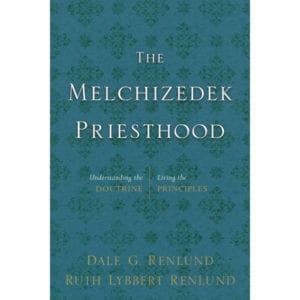
There have been some General Conference talks in recent years about the priesthood that have really stuck out for me, such as “Healing the Sick” by Dallin H. Oaks in April 2010, and “The Price of Priesthood Power” by Russell M. Nelson in April 2016. As an elder in the Melchizedek Priesthood, they have been very instructional but have also left me wanting to know more about the priesthood and how to better exercise priesthood power. This book, by apostle Dale G. Renlund and his wife, Ruth Lybbert Renlund, goes a long way towards doing that.
It consists of two parts, titled “Foundations of the Priesthood” and “Doctrine of the Priesthood.” In the first part, it explains what priesthood is, its purpose, the offices and keys, and the oaths and covenants associated with it. The second part talks about putting the priesthood into action and becoming better priesthood holders. At the end of the book there is also a small section of “Chapter Summaries” that can serve as a review of the material contained in the book.
It begins by talking about what the priesthood is. “The offices of the Aaronic and Melchizedek Priesthood do not constitute all of God’s priesthood, His total power and authority. Brigham Young taught that there are many aspects of God’s total priesthood power and authority that are not delegated to men on earth… the authority and power to produce bodies and spirits, create kingdoms, and organize matter.” (pages 12-13) It talks about God’s priesthood power and authority being used on the earth even between New Testament times and the restoration of the priesthood through Joseph Smith. It also addresses the issues of people of African descent being denied priesthood blessings for a time, and priesthood offices only being open to males. “Women in the Church frequently exercise priesthood power and authority, though they are not ordained to priesthood offices.” (page 18)
Many analogies, stories, and historic details are given to explain each concept that is presented. For example, accounts by Wilford Woodruff and Parley P. Pratt of receiving all the keys from Joseph Smith are used to help explain what happens when the prophet dies and the senior apostle takes his place. Some will be critical of the book for including the infamous story of Thomas B. Marsh and the milk strippings, as told by George A. Smith. (For a more balanced account, refer to the entry in the Revelations in Context section at http://history.lds.org titled “The Faith and Fall of Thomas Marsh.”) However, it would be a real shame to disregard the entire book because of that.
The second part of the book gives a lot of practical advice about using the priesthood, with sections such as “The Proper Exercise of Priesthood is Learned,” “A Priesthood Holder Delegates and Accepts Delegated Responsibility,” “A Priesthood Holder Gives and Receives Correction,” and “A Priesthood Holder Judges Righteously.” Many interesting personal stories are related from Elder Renlund’s years of priesthood service up through being called as an apostle to help illustrate each point. He even talks about how he was ordained an apostle, and some of the words that were said during the ordination: “We give you every right, gift, authority, and the keys of this sacred office, including the keys of prophet, seer, and revelator to be shared with your Brethren in this circle.” (page 28)
There is helpful information in this book for every Melchizedek Priesthood holder, from one newly ordained, to one serving in a leadership position such as bishop, stake president, or high council. Advice is given on how best to hold council meetings, receive confessions and help people who have committed serious sins, and how to kindly give correction as well as to receive it. “The priesthood holder should become a better husband and father as he incorporates the doctrine of the priesthood into his life. The principles that are necessary to use the priesthood are the same principles that will help a man be better at home.” (page 23)
I got more out of the book than I expected, and plan to refer back to it as needed for a reference in my own life as well as a help for teaching my sons. It would also be a great tool for someone preparing to serve a mission or a newly called elders quorum president or bishop.
